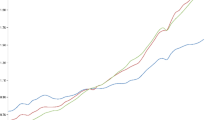Abstract
Most of the socio-economic phenomena such as development, well-being, and quality of life have a multidimensional nature and require the definition of a set of individual indicators to be properly assessed. Often, individual indicators are summarized and a composite index is created. One of the main problems in constructing composite indices is the choice of a method which allows time comparisons. In this paper, we consider the Adjusted Mazziotta–Pareto Index, a non-compensatory composite index used by the Italian National Institute of Statistics for measuring “Equitable and Sustainable Well-being” in Italy. An empirical comparison with some traditional non-compensatory indices is presented and an Influence Analysis is, for the first time, performed in order to assess the robustness of the index.

Similar content being viewed by others
Notes
Note that we call ‘non-compensatory’ a not fully compensatory approach. With partial compensability, only small (less than a given amount) decreases in one component may be compensated by suitable increases of the other components (Bramanti and Tarantola 2012).
To overcome the assumption of full substitutability among indicators, some authors propose multiplicative aggregation methods, such as the geometric mean (OECD 2008; Zhou et al. 2010). However, the value of the geometric mean is ‘biased’ low. Thus it may be useful for measuring phenomena like development (e.g., the HDI), but not like poverty.
The ‘polarity’ of an indicator is the sign of the relation between the indicator and the phenomenon to be measured (+ if the indicator represents a dimension considered positive and − otherwise).
It is a generalized form since it includes ‘two indices in one’.
Educational attainment is measured as the percentage of the adult population (15–64 years of age) holding at least an upper secondary degree, as defined by the OECD-ISCED classification.
Note that only normalization methods to perform time comparisons in absolute terms are considered (re-scaling and distance to a reference).
Influence Analysis is a particular case of Uncertainty Analysis (Saisana et al. 2005) that aims to empirically quantify the ‘weight’ of each individual indicator in the calculation of the composite index.
Note that X1 (Life expectancy) has the lowest coefficient of variation.
References
Bandura, R. (2008). A Survey of composite indices measuring country performance: 2008 Update. A UNDP/ODS Working Paper, New York.
Booysen, F. (2002). An overview and evaluation of composite indices of development. Social Indicators Research, 59, 115–151.
Bramanti, A., & Tarantola, S. (2012). Regional innovation index—Regional champions within national innovation systems. Luxemburg: European Commission, JRC Scientific and Policy Reports.
Casadio Tarabusi, E., & Guarini, G. (2013). An unbalance adjustment method for development indicators. Social Indicators Research, 112, 19–45.
De Muro, P., Mazziotta, M., & Pareto, A. (2011). Composite indices of development and poverty: An application to MDGs. Social Indicators Research, 104, 1–18.
Freudenberg, M. (2003). Composite indicators of country performance: A critical assessment. OECD, DSTI/IND, 5, Paris.
Istat (2015). BES 2015. Il benessere equo e sostenibile in Italia. Available at: http://www.istat.it/it/files/2015/12/Rapporto_BES_2015.pdf.
Mazziotta, M., & Pareto, A. (2013). Methods for constructing composite indices: One for all or all for One? Rivista Italiana di Economia Demografia e Statistica, LXVII(2), 67–80.
Mazziotta, M., & Pareto, A. (2016). On a generalized non-compensatory composite index for measuring socio-economic phenomena. Social Indicators Research, 127, 983–1003.
Michalos, A. C., Smale, B., Labonté, R., Muharjarine, N., Scott, K., & Moore, K., et al. (2011). The Canadian index of wellbeing. Technical Report 1.0. Waterloo, ON: Canadian Index of Wellbeing and University of Waterloo.
OECD. (2008). Handbook on constructing composite indicators. Methodology and user guide. Paris: OECD Publications.
OECD (2015). Measuring well-being in Mexican States. Paris: OECD Publishing. Available at: http://dx.doi.org/10.1787/9789264246072-en.
Saisana, M., Tarantola, S., & Saltelli, A. (2005). Uncertainty and sensitivity techniques as tools for the analysis and validation of composite indicators. Journal of the Royal Statistical Society A, 168, 307–323.
Saltelli, A. (2007). Composite indicators between analysis and advocacy. Social Indicators Research, 81, 65–77.
Salzman, J. (2003). Methodological choices encountered in the construction of composite indices of economic and social well-being. Technical Report, Center for the Study of Living Standards, Ottawa.
Tarantola, S. (2008). European innovation scoreboard: Strategies to measure country progress over time. JRC scientific and Technical Reports, EUR 23526 EN, Luxembourg.
UNDP. (2001). Human development report 2001. New York: Oxford University Press.
UNDP. (2010). Human development report 2010. New York: Palgrave Macmillan.
Zhou, P., Ang, B. W., & Zhou, D. Q. (2010). Weighting and aggregation in composite indicator construction: A multiplicative optimization approach. Social Indicators Research, 96, 169–181.
Acknowledgements
The paper is the result of the common work of the authors: in particular M. Mazziotta has written Sections 1, 2, 5 and A. Pareto has written Sections 3 and 4.
Author information
Authors and Affiliations
Corresponding author
Rights and permissions
About this article
Cite this article
Mazziotta, M., Pareto, A. Measuring Well-Being Over Time: The Adjusted Mazziotta–Pareto Index Versus Other Non-compensatory Indices. Soc Indic Res 136, 967–976 (2018). https://doi.org/10.1007/s11205-017-1577-5
Published:
Issue Date:
DOI: https://doi.org/10.1007/s11205-017-1577-5




